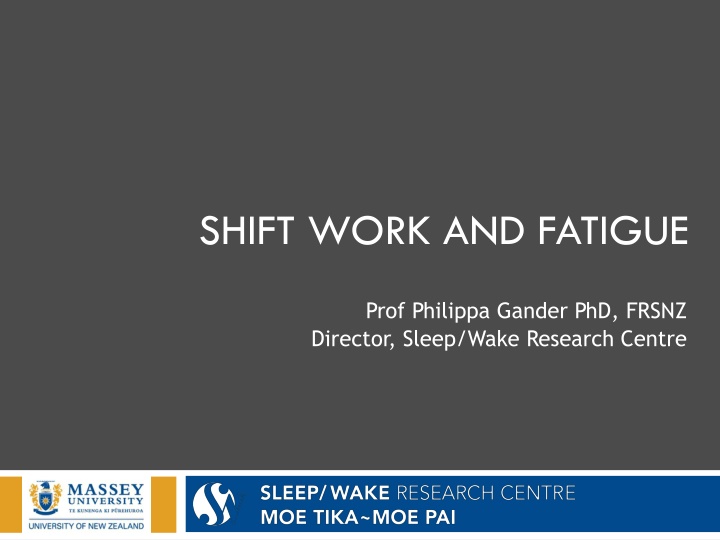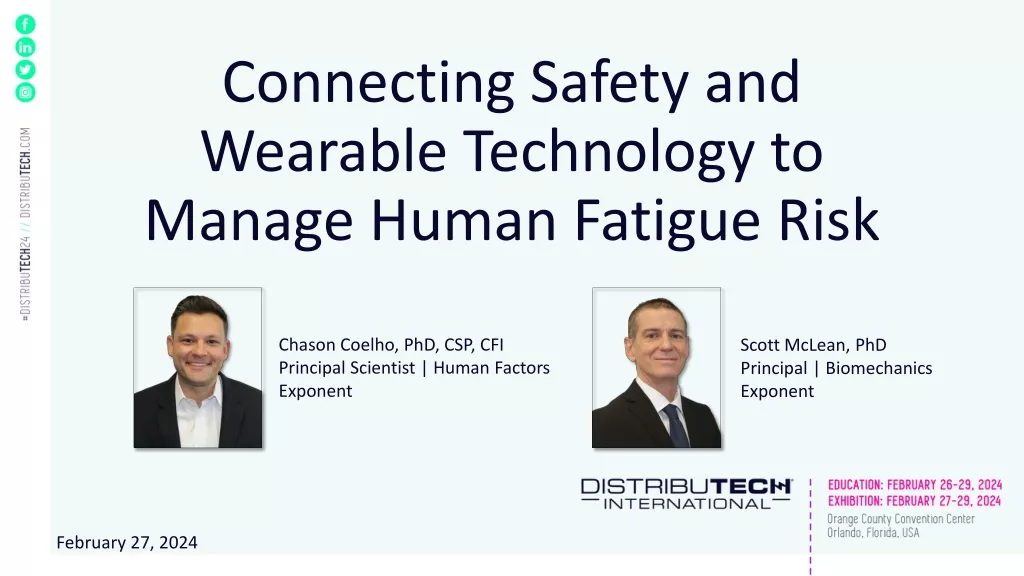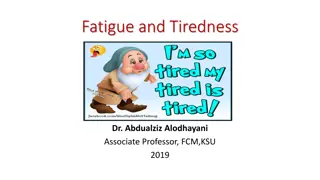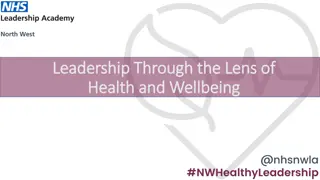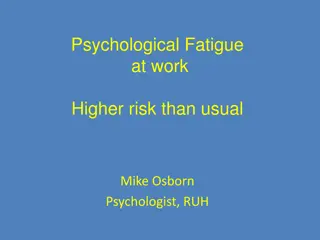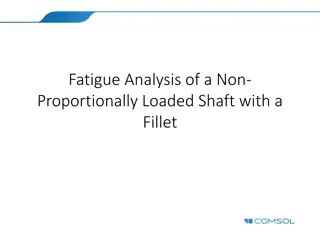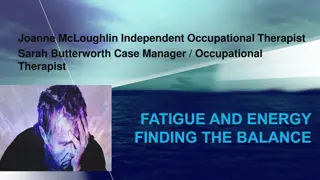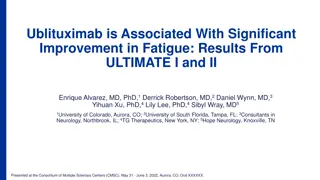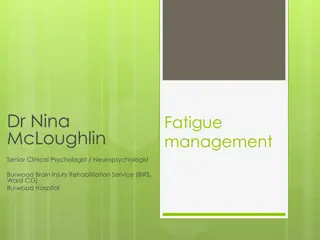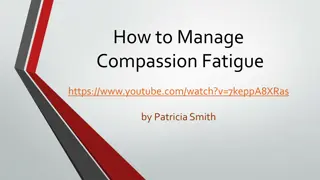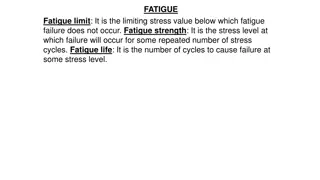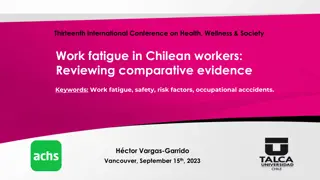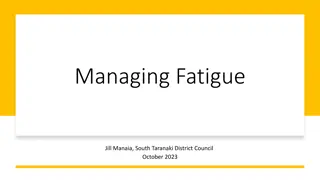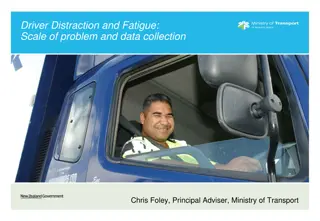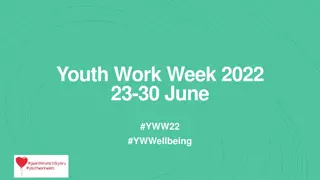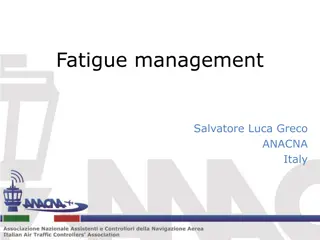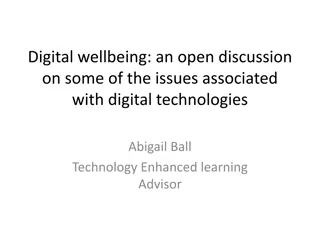Managing Fatigue and Shift Work: Impact on Safety and Wellbeing
Understanding the legal requirements, effects of fatigue and shift work, and ways to manage fatigue is crucial for ensuring workplace safety and employee wellbeing. Fatigue, a state of reduced performance capability, can result from various factors, including sleep loss and workload. Shift work poses a risk of fatigue, impacting patient and nurse safety. Long hours can lead to increased incidents of errors and injuries. Effective fatigue risk management is essential for maintaining a safe work environment.
Download Presentation

Please find below an Image/Link to download the presentation.
The content on the website is provided AS IS for your information and personal use only. It may not be sold, licensed, or shared on other websites without obtaining consent from the author.If you encounter any issues during the download, it is possible that the publisher has removed the file from their server.
You are allowed to download the files provided on this website for personal or commercial use, subject to the condition that they are used lawfully. All files are the property of their respective owners.
The content on the website is provided AS IS for your information and personal use only. It may not be sold, licensed, or shared on other websites without obtaining consent from the author.
E N D
Presentation Transcript
SHIFT WORK AND FATIGUE Prof Philippa Gander PhD, FRSNZ Director, Sleep/Wake Research Centre
Outline Legal requirements What is fatigue? Effects of fatigue and shift work A more comprehensive approach to managing fatigue and shift work Conclusions
HSE Amendment Act (2002) Fatigue is a hazard than can cause harm Employers must: take all practicable steps to prevent harm occurring to employee adopt a systematic approach to identifying, assessing, and controlling hazards at work. Employees must: Arrive fit for work. Behave safely in the workplace Cooperate in safety, report hazards Shift work is a cause of fatigue Any work pattern that displaces sleep time New Health and Safety at Work Act Government intent - into force from 1 April 2015
What is fatigue? Fatigue A physiological state of reduced mental or physical performance capability Results from sleep loss or extended wakefulness, circadian phase, or workload (mental and/or physical activity) Can impair a person s alertness and ability to work safely and efficiently Two approaches for managing fatigue Working time limits One size fits all Fatigue risk management Measure and manage actual fatigue levels and risk Manage the hazard
Effects of fatigue and shift work Patient safety Nurse safety, health, well being Physiological effects of shift work
Long Hours and Safety (11,516 nurses) Odds ratio P value Occasional/frequent wrong med or dose 1.28 (1.20-1.49) <0.01 Occasional/frequent falls with injury 1.17 (1.02-1.36) <0.05 Olds DM, Clarke SP (2010) Journal of Safety Research 41: 153-162 Occasional/frequent nosocomial infections 1.14 (1.02-1.28) <0.05 Occasional/frequent work injuries 1.25 (1.11-1.40) <0.001 Any needle stick injuries in the last year 1.28 (1.08-1.52) <0.01 Adjusted for nurse characteristics: sex, unit type, age, years of experience as RN, education level, hospital -level staffing, temporary employment, dependents at home, union membership, nursing education outside the USA Needlestick injuries also adjusted for risk factors including starting IVs, routine phlebotomy on last shift, presence of sharps safety devices
Shift Work, Sleep, &Safety (365 nurses) Work Days Non-Work Days 119/365 nurses on rotating ( 4 day/evening shifts, 4 night shifts per month) 2x more likely to nod off driving to or from work 2x more likely to report accidents/errors due to sleepiness (work-related and driving) Gold DR et al (1992) American Journal of Public Health 82:1011-1014
Nurses: Shift Work and Family Partner Nurse Shift work conflict Days off Relationship harmed Night shift Relationship disrupted Afternoon shift Relationship has suffered Day shift Joint social life disrupted 0 50 100 0 50 100 % reporting moderate-high disruption (n=50) % reporting insufficient contact with children (n=22) Lushington et al., 1997
Shift work is a physiological challenge Light sensitive circadian pacemaker in the SCN doesn t adapt Trying to work when least functional Eating at physiologically inappropriate times Trying to sleep when primed for wake sleep at night is not just a social convention Shift work = displaced sleep
Sleep and Health Shift work restricts sleep Population-based studies - usual sleep < 7 hours increases risk of: obesity, impaired glucose tolerance, type 2 diabetes mellitus, cardiovascular disease, poor general health and premature mortality Experimental sleep restriction studies - potential mechanisms increased caloric intake, decreased physical activity and/or altered thermoregulation, impaired glucose metabolism, increases in blood pressure, sympathetic nervous system activity, and inflammatory markers of cardiovascular risk
Shift work a carcinogen? International Agency for Research on Cancer (IARC) (2007) conclusion, based on: Limited evidence in humans for the carcinogenicity of shift-work that involves night work Sufficient evidence in experimental animals for the carcinogenicity of light during the daily dark period ( biological night ) Shift work that involves circadian disruption is probably carcinogenic to humans (Group 2A)
A more comprehensive approach Identify fatigue hazards A fatigue risk matrix Other ways of identifying fatigue hazards Act on identified fatigue hazards
The perfect roster is permanent day work Managing sleep opportunities how fast is sleep debt building up? how long since 2 full nights of sleep in a row? Managing risks at work how tired are staff going to be on this shift? how difficult are the work demands/conditions? how long should they keep going? Getting people home safely Managing work/life balance each person reacts differently regular, predictable work patterns help time management fair distribution of weekends off staff input in roster design, management
AMA Total Risk Score (last week) Risk factor Low risk (0 points) Significant risk (1 point) Higher risk (2 points) < 50 hrs 50-70 hrs > 70 hrs Hours worked All shifts < 10 hrs 0-1 shift 14 hrs At least 2 shifts 14 hrs Shift length No shift longer than rostered, all shifts < 24 hrs At least 1 shift longer than rostered but < 24 hrs At least 1 shift 24 hrs Extended shifts On call 0-2 days On call 3-6 days On call 7 days On call 0-1 night duty 2 night duties Night duty 3 night duties 0 breaks < 10 hrs 1-2 breaks < 10 hrs More than 2 breaks < 10 hrs Breaks < 10 hrs At least two 24-hr breaks One 24-hr breaks No 24-hr breaks 24-hr breaks No change, predictable roster Change, Change, unpredictable roster Roster change predictable roster 6-7 nights 4-5 nights 0-3 nights Sleep at night (2300-0700) 6-7 days 4-5 days 0-3 days Enough sleep
Total Risk Score, 1366 NZ RMOs 10 9 8 7 Average total risk score/20 6 5 4 3 2 1 0 Specialty
Not only long hours, NZ RMOs Excessive hours Worked >10/14 days 2 or more shifts >14 hrs in a week 3 or more night shifts in a week More than 1 break <10 hrs Roster change both weeks Total risk score Outcomes Excessive daytime sleepiness (ESS >10) 1.54 ns 1.53 ns 1.81 3.54 Sleepy at the wheel driving home, last year ns ns 1.53 ns 1.78 2.33 Fatigue-related clinical error, last 6 months ns 1.37 ns ns 1.85 Compared to <50 hrs both wks, or 50-70 hrs 1 wkk 0-10 days no 0-1 per week none No change Lowest 3rd Adjusted for: gender, age, sleep habits, number of dependents, commute times, position, time studying, frequency of adequate supervision
Data for hazard identification Incident reports is fatigue included as a possible contributing factor? who analyses them? trends? feedback to staff? Analyse planned versus actual work patterns Fatigue reports? An effective safety reporting culture distinguishes between unintentional human errors - a normal part of human behaviour managed within the safety system deliberate violations of rules and established procedures a disciplinary matter dealt with outside the safety system A roster risk assessment matrix for nurses
Fatigue risk assessment & mitigation How are other identified hazards managed? Organizational structures, accountability all practicable steps Shared responsibility
Conclusions Shift work and fatigue affect Patient safety Nurse safety, health, wellbeing Shift work and fatigue risk management requires: More than managing hours of work Rosters Identify hazard(s), asses risk, mitigate, monitor shared responsibility (a whole of life issue ) workforce/management collaboration a shared knowledge base education/training on causes of fatigue, management strategies
